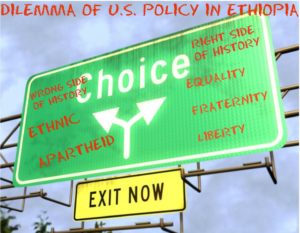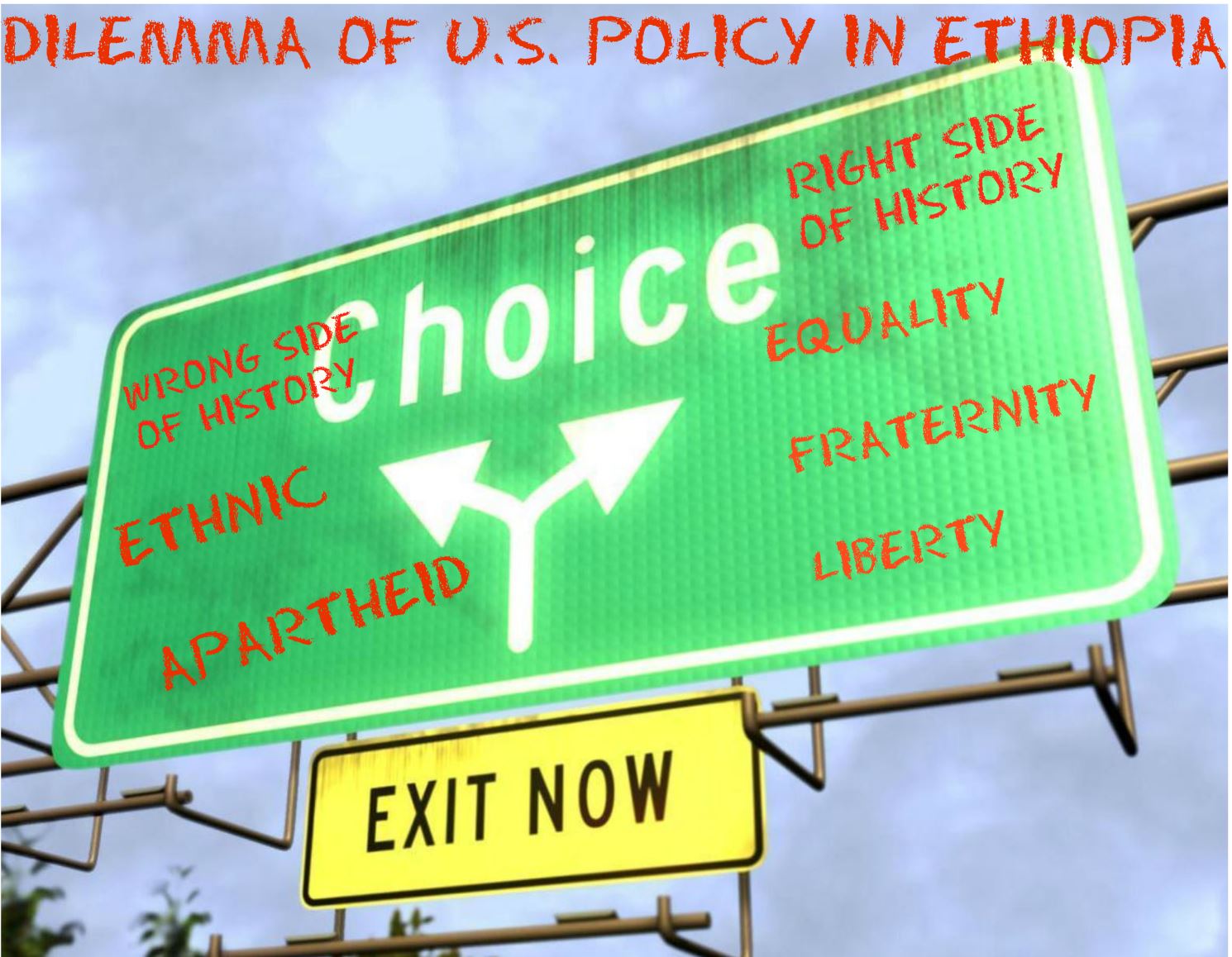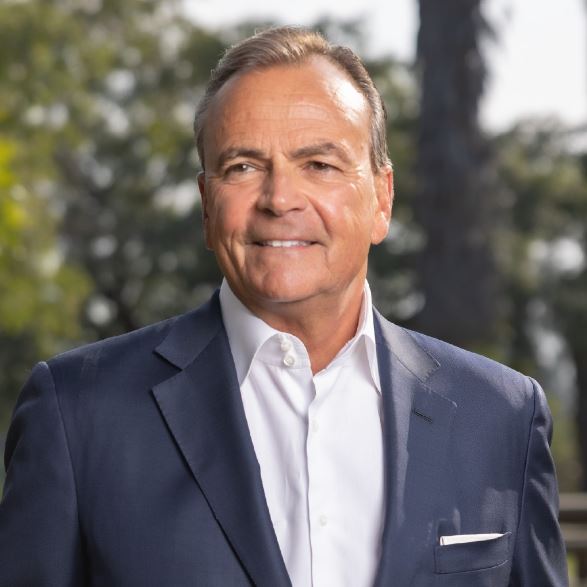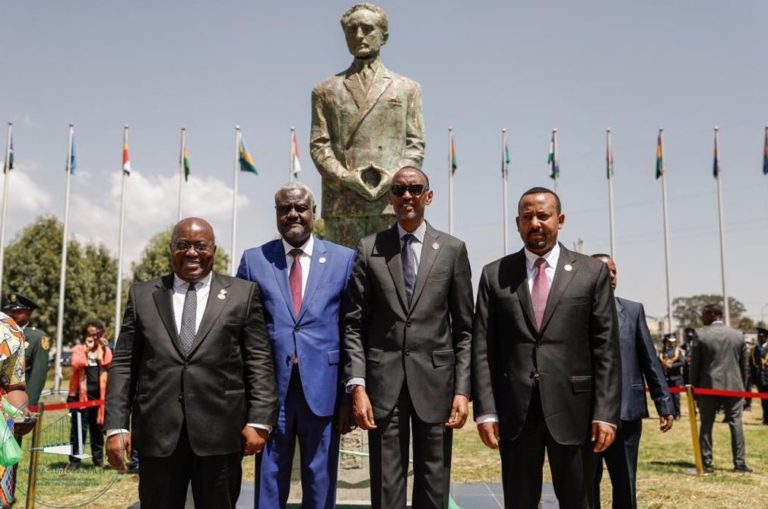Ethiopia-Win-Et: The U.S. on the Horns of a Creeping Civil War Dilemma in Ethiopia
Those who make peaceful revolution impossible will make violent revolution inevitable…In the past, those who foolishly sought power by riding the back of the tiger ended up inside.” — John F. Kennedy
The quiet riot of civil disobedience in Ethiopia over the past two years is slowly morphing into a creeping and enveloping civil war. — Alemayehu G. Mariam
Author’s Note: I have postponed the second installment of my “Deconstructing T-TPLF’s Ethnic Federalism” series in light of the deteriorating situation in Ethiopia today.
In this commentary, I shall examine the apparent gradual change from a quiet riot of civil disobedience to certain civil war in Ethiopia and the real reasons underlying civil strife in that country and offer analysis and policy recommendations on the necessity for U.S. mediatory involvement to avert what appears to be an irreversible trajectory towards civil war.
From a quiet riot of civil disobedience to civil war?
 The quiet riot which began in earnest in Ethiopia over two years ago is today definitely looking like a creeping civil war.
The quiet riot which began in earnest in Ethiopia over two years ago is today definitely looking like a creeping civil war.
Ethiopia today is at a tipping point where civil disobedience appears to be mutating into civil war. Uprisings, protests, demonstrations, open rebellions and defiant challenges to the rule of the Thugtatorship of the Tigrean People’s Liberation Front (T-TPLF) are visible in every part of the country. The people are angry, frustrated, outraged, resentful and defiant against T-TPLF rule.

In its 2017 report on Ethiopia, Human Rights Watch (HRW) documented the large-scale “crack-down” by “Ethiopian security forces” against “largely peaceful demonstrations, killing more than 500 people.” HRW also documented that, “Security forces arrested tens of thousands of students, teachers, opposition politicians, health workers, and those who sheltered or assisted fleeing protesters.” HRW’s findings are corroborated by the U.S. State Department and Freedom House.
To paraphrase the great American revolutionary Thomas Paine, the Ethiopian people “have found out the exact amount of injustice and wrong which will be imposed upon them” by the T-TPLF and are standing up to vindicate the principle that “The limits of tyrants are prescribed by the endurance of those whom they oppress.” Their endurance over the past 25 years has now become steely defiance.
I talked about the Ethiopian powder keg attached to a slow burning fuse in my August 2016 commentary, “The Volcano, the Beast and the Tiger”. In my May 2017 commentary, “The Good Kops/Bad Kops T-TPLF Con Game (Over)”, I pointed out the irrefutable fact that the T-TPLF today barely clings to dear political life sitting on a powder keg holding by a thread it calls a “state of emergency” decree. (Of course, it must be noted that Ethiopians have been under an undeclared state of emergency in a police state for the past 25 years.) With the emergency decree, the T-TPLF effectively declared martial law or as they called it “command post” administration giving themselves license to kill, jail, torture, persecute and prosecute and terrorize the civilian population at will.
As I observed in my October 2016 commentary, “State of Emergency or T-TPLF S.O.S. (Save Our Souls/Ship) Emergency?”, the T-TPLF did not declare a state of emergency for Ethiopia. It declared an emergency S.O.S. for the “S.S. T-TPLF”. It was plain to see that the T-TPLF Ship of State is sinking, and sinking fast. The S.S. T-TPLF has been struck by a tsunami of the Ethiopian peoples’ anger, frustration and outrage.
The whole object of the state of emergency decree was to buy time for the T-TPLF to come up with a plan to crush the peoples’ defiant spirit, erode their will to resist and destroy their will and morale to fight, disrupt their networks, confuse their thinking process and sow dissension among the opposition, ultimately leading to a complete surrender. It did not work.
At best, the state of emergency decree only sprinkled dirt over the red-hot burning embers of anger and frustration with T-TPLF rule. In August 2017, the T-TPLF announced it had lifted the state or emergency because things were under control. But that did not last long. The protests flared once again and spread throughout the country like wildfire.
Immediately after the “lifting” of the state of emergency, the people, particularly the youth, resumed their mass acts of civil disobedience and nonviolent resistance. Business owners were refusing to pay the T-TPLF’s outrageous taxes. Massive boycotts and strikes against the T-TPLF took place. Poor farmers were in full resistance mode against expropriation of their land by The T-TPLF. Everyday, the young people of Ethiopia are standing up defiantly and proclaiming to the T-TPLF, “Enough is enough! We ain’t gonna take it no more.”
Over the past six months, the pressure in the Ethiopian powder keg has been building up by the second, minute and hour. There is no safety valve to release the pressure, only increasing compression and oppression.
Today, the T-TPLF house of cards is coming apart, brick-by-brick and nail-by-nail before our eyes. The T-TPLF’s doomsday is near and certain. There are only two unanswered question: Whether the powder keg will go off with a bang or a whimper, and whether it will happen in daylight or come like a thief in the night.
Ethiopia today is at a tipping point, a breaking point. It has passed the point of no return. No return to T-TPLF ethnic supremacy. No return to T-TPLF corrupt rule. No return to T-TPLF divide and rule. No return to T-TPLF oppression.
The T-TPLF has tried everything to turn the tide of history, or better phrased, its own trajectory towards the trash bin of history.
The T-TPLF bosses believed their usual militarized response of indiscriminate massacres and large-scale arrests and detentions of opponents and dissidents were all it took to keep them on top. They arrested and detained tens of thousands of people and killed thousands more. It did not work.
The T-TPLF bosses have tried all manner of political window dressing, none of which worked: cabinet shuffling to pretend they are making leadership changes, bogus corruption investigations and prosecutions to create public distraction, disinformation and propaganda campaigns to confuse and mislead the population, organization of bogus national dialogue forums with hand selected ethnic and opposition representatives to hoodwink the donors and loaners, trotting out opposition leaders with dubious pasts to create the impression of reaching out and being inclusive, sending out their own members pretending to be regime critics to capture and lead the public debate and discussion on bogus reform and a variety of other empty gestures to cling to power.
The T-TPLF is so desperate that for the past weeks it has been putting on a political drama pretending to have serious conflicts among its own leaders. They have released propaganda purportedly showing strife and division among themselves, including the staged dramatic walkout of their late thugmaster’s wife from one of their meetings.
The T-TPLF continues to put on a show at its home base. They keep leaked out disinformation that there is great conflict among the leaders who want a harder crackdown on protesters and others who favored a more conciliatory and accommodationist approach. They played musical chairs with the top bosses changing positions in a futile attempt to demonstrate to the public they are making real changes.
It is all much ado about nothing. The T-TPLF bosses could put on whatever political drama they want, but the bottom line is nobody gives a _ _ _t.
“The T-TPLF gotta go! Where they belong. The trash heap of history.”
The T-TPLF’s political window dressing strategy suffered a major blow when Abadulla Gemeda, the “Speaker of the House of the Peoples’ Representatives”, the T-TPLF’s rubberstamp parliament, dumped them. Abadulla said he resigned because of “disrespect” and an attack on the “dignity of Oromo people.”
Baye Tadesse Tefferi, the 20-year veteran protocol chief of T-TPLF prime minister Hailemariam Desalegn defected while attending the United Nations annual meeting and sought political asylum in the U.S. Baye, in a Voice of America interview, said he decided to defect because he feared being whacked by the T-TPLF mafia.
Melaku Shiferaw Tiruneh, Brigadier General in the T-TPLF army, also defected to the US while attending anti-terrorism conference.
Today, dozens of universities in Ethiopia are under siege by T-TPLF troops and have become killing fields. Street battles between T-TPLF troops armed with AK-47 and rock-throwing youth are daily occurrences throughout the country.
The so-called coalition members of the T-TPLF have reportedly refused to attend rubber-stamp parliamentary sessions until an investigation into the recent killings are conducted. They have threatened to bring the T-TPLF soldiers who committed crimes against humanity to justice in their regional courts.
The country’s economy is tanking. Ethiopia labors under crushing foreign debt (nearly $40 billion in 2016 representing 54.8 percent of GDP). Consumer prices in Ethiopia increased 13.6 percent year-on-year in November of 2017, the highest inflation rate since November of 2012.
In May 2017, the T-TPLF reported its “foreign reserves have dropped to a level only enough for 2.3 months of imports”. In October 2017, the T-TPLF devalued its currency by 15 percent. Ethiopia’s economy is in shambles.
Ethnic conflict is NOT, NOT the cause of the creeping civil war in Ethiopia
T-TPLF bosses have been predicting ethnic civil war for decades if they are no longer in power. Meles and his TPLF disciples have been crying ethnic wolf (“Rwandan Interahamwe”) all these years to scare people into supporting them.
Well! The wolf has arrived! In the sheep’s clothing of civil disobedience, nonviolent resistance and noncooperation. Now the wolf appears to be taking off his sheep’s clothing and baring his teeth. The T-TPLF created its kililistans and now it has come face to face with hungry and angry wolves out of the kililistan lairs.
The T-TPLF leaders have always dragged out the ethnic boogeyman as the cause of civil war. The late T-TPLF thugmaster Meles Zenawi used to scaremonger that after his TPLF goes, there will be the equivalent of an “Interahamwe-type Hutu militia which massacred Tutsis in Rwanda”. Zenawi repeated his prediction of ethnic bloodbath time and again.
Zenawi’s sidekick and step-and-fetch it, Bereket Simon, went one step further when he predicted, “Strife between different nationalities of Ethiopia might have made the Rwandan genocide look like child’s play.”
T-TPLF general Tsadkan Gebretensaye straight up predicted civil war when the T-TPLF is dumped in the trash bin of history.
T-TPLF boss Abay Tsehai predicted Ethiopia will be Africa’s 21st century Rwanda. He said things in Ethiopia are getting out of control and Ethiopia and is careening into becoming the next Rwanda.
T-TPLF boss, Seyoum Mesfin, also expects a civil war but believes his T-TPLF will crush all opposition and remain dominant. In a bizarre interview, Seyoum effectively equated Ethiopians to Nazis and Tigreans to Jews in the Third Reich.
Only the T-TPLF godfather Sebhat Nega got it right. “When the people become very bitter, they explode. This is a universal truth. There are no people who will not rise up when they become bitter. Historically. Now. And in the future.”
The people of Ethiopia are bitter and they are exploding day by day.
It is absolutely important to understand that the massive uprisings and resistance against the T-TPLF in the Oromia and Amhara regions of the country are not motivated by hatred of Tigreans as the T-TPLF bosses want the world to believe. The real issue is that the T-TPLF has made ethnic supremacy the very foundation of its omnipotent political, economic and social power.
Herman Cohen, former Assistant Secretary of State for African Affairs and an appointee of George H.W. Bush, who facilitated the TPLF’s transition to power in Ethiopia in 1991 after the cowardly military junta leader fled to Zimbabwe offers a compelling analysis:
Since 2005, there has been growing political unrest in Ethiopia. Several of the individual states feel discriminated against by the group controlling the national government, the Tigrayan People’s Liberation Front (TPLF). In addition to ethnic discrimination, the national government has refused to implement political reforms. All elections are rigged. On the economic side, the non-Tigrayan population in regional states is resentful that the TPLF is monopolizing the entire economy.
Cohen’s analysis is supported by irrefutable facts.
Following the 2015 “election”, The T-TPLF owned 100 percent of “parliament”.
Following the 2010 “election”, the T-TPLF owned 99.6 percent of the “parliament”.
The TPLF owns 100 percent of the land in Ethiopia and can confiscate and expropriate lands at will from individuals and groups as it has done repeatedly in Oromia, Gambella and other regions.
The T-TPLF owns 100 percent of the top military leadership positions in Ethiopia.
The T-TPLF owns 100 percent of the top businesses and economic enterprises in Ethiopia.
The T-TPLF owns 100 percent of the civil service jobs and political appointments in Ethiopia.
These are the causes of the looming civil war in Ethiopia, not ethnic hatred against Tigreans by other ethnic groups.
The T-TPLF bosses have pulled the ethnic card to scaremonger Tigreans into believing that without the T-TPLF, they will all suffer the fate of Tutsi’s in Rwanda. The T-TPLF has long traded on the myth that its fate and destiny is in fact the fate and destiny of the people of Tigray. The truth is that the T-TPLF represents no one but its members, supporters and cronies from all ethnic groups and religions who feed at its trough of corruption.
U.S. watching a quite riot or an oncoming train wreck from the sidelines?
The U.S. is watching from the sidelines. It is not clear to me if it is watching a quiet riot or an oncoming train wreck.
The United States has been and continues to monitor “reports fo violence and protests”. It is not clear what the U.S. is doing behind the scenes to prevent a deterioration of the political situation in the country, but there is a clear change in U.S. policy in Ethiopia (discussed below).
The publicly available evidence suggests the U.S. is probably doing more than just monitoring the deteriorating situation in Ethiopia. Behind the façade of apparent concern and unease, there seems to be a sense of urgency and alarm as evidenced in the various official warnings, advisories and statements.
On December 6, 2016, the U.S. State Department “continue[d] to warn U.S. citizens of the risks of travel to Ethiopia due to the potential for civil unrest related to sporadic and unpredictable anti-government protests that began in November 2015.”
On June 13, 2017, the U.S. State Department issued a “Travel Warning” advising “U.S. citizens of the risks of travel to Ethiopia due to the potential for civil unrest and arbitrary detention since a state of emergency was imposed in October 2016. The Government of Ethiopia extended the state of emergency on March 15, 2017, and there continue to be reports of unrest, particularly in Gondar and Bahir Dar in Amhara State. This replaces the Travel Warning of December 6, 2016…”
On August 10, 2017, the U.S. Embassy in Ethiopia issued a travel warning to its citizens to avoid “the main road from Addis Ababa to Jijiga [which] has been blocked by security forces between the cities of Babile and Harar due to intense fighting including gunfire. Ethiopian Defense Force troops are arriving in the area, and the road is not passable.”
On August 25, 2017, the U.S. Department of State “warn[ed] U.S. citizens of the risks of travel to Ethiopia due to the potential for civil unrest and arbitrary detention. There continue to be reports of unrest, particularly in the Gondar region and Bahir Dar in Amhara State, and parts of Oromia State. This replaces the Travel Warning of June 13, 2017.”
On September 14, 2017, the U.S. Embassy in Ethiopia issued a “security message” warning that because of “armed clashes near the border region between the Somali and Oromia regional states, the Embassy is reviewing and approving on a case by case basis all personal and official travel to East and West Hararge, Borena, and Guji areas of Oromia regional state.”
On September 19, 2017, the U.S. Embassy issued a statement of concern:
We are disturbed by the troubling reports of ethnic violence and the large-scale displacement of people living along the border between the Oromia and Somali regions, particularly in Hararge, although the details of what is occurring remain unclear… [O]n the local level, communities must be encouraged and given space to seek peaceful resolutions to the underlying conflicts.
We believe Ethiopia’s future as a strong, prosperous, and democratic nation depends on open and inclusive political dialogue for all Ethiopians, greater government transparency, and strengthening the institutions of democracy and justice. These recent events underscore the need to make more rapid and concrete progress on reform in these areas.
On September 29, 2017, the U.S. Embassy in Ethiopia “advised U.S. citizens to postpone travel to Bishoftu (Debre Zeit) [60 km south of Addis Ababa] and its surrounding areas.”
On October 11, 2017, the U.S. Embassy in Ethiopia issued a warning to its citizens to be aware of “violent protests and road closures in and around Shashamane, approximately 250 km south of Addis Ababa.”
On October 18, 2017, the U.S. Embassy in Ethiopia issued the following statement:
United States sees peaceful demonstrations as a legitimate means of expression and political participation. We note with appreciation a number of recent events during which demonstrators expressed themselves peacefully, and during which security forces exercised restraint in allowing them to do so. We are saddened by reports that several recent protests ended in violence and deaths. All such reports merit transparent investigation that allows those responsible for violence to be held accountable. (Emphasis added.)
On October 26, 2017, the U.S. Embassy in Ethiopia issued a travel warning to its citizens to be “aware of reports of violent protests and road closures in the areas of the region of Oromia near Ambo, Bako, and Holeta, west of Addis Ababa.”
On December 12, 2017, the Washington Post reported, “Ethiopia faces a social media blackout as clashes intensify between ethnic groups in various parts of the country. Facebook and Twitter are down Tuesday after reports emerged of killings on Monday by security forces in the Oromia region.”
On December 13, 2017, the U.S. Embassy in Ethiopia issued a statement of condolences to the families of T-TPLF massacres. “We are troubled and saddened by reports of violence that has resulted in deaths and injuries in the town of Chelenko and at several universities over the past two days. We extend our condolences to the families and friends of the victims.”
Trump administration’s policy in Ethiopia: What needs to be done
First, good riddance to the bad old days!
Gone are the bad old Obama days of handing over the master key to the USAID Candy Store to the T-TPLF.
Gone are the bad old Obama days of handing over billions of dollars in American taxpayer dollars to prop up the T-TPLF.
Gone are the bad old Obama days of extortion of the American taxpayer by threatening to refuse cooperation on anti-terrorism actions.
Gone are the bad old Obama days of hemorrhaging billions of American tax dollars down a rabbit hole of corrupt African dictators. On December 14, 2017, the U.S. announced it “is suspending food and fuel aid for most of Somalia’s armed forces over corruption concerns” and because “failed to meet the standards for accountability for U.S. assistance”. Such action would have never have occurred during the bad old Obama days.
Gone are the bad old Obama days of turning a blind eye to crimes against humanity and extreme repression in Ethiopia. Michael Raynor, President Trump’s ambassador to Ethiopia recently issued a statement declaring, “United States sees peaceful demonstrations as a legitimate means of expression and political participation.” Obama’s ambassador would have never, never, made such a statement!
Gone are the Obama days of calling a regime that claimed to have won 100 percent of the seats in parliament “democratically elected”.
Gone are the days of talking the talk of the “right side of history”.
The evidence is clear that the U.S.today is walking on the right side of history with the people of Ethiopia.
As I previously confessed, I admit I was wrong in believing Trump would blindly follow in Obama’s footsteps and continue to handout billions of dollars to the T-TPLF. I was so confident Trump would be an Obama clone in his Africa policy, I declared in my December 2016 commentary , “Trump, Out of Africa”, that I would eat crow if he did anything different.
Today, I maintain a well-stocked pantry of vegan crow for regular consumption.
Barack Obama created the false dilemma between U.S. national security by combatting terrorism in the Horn of Africa and human rights in Ethiopia. Barack Obama supported the T-TPLF despite their long and documented history, by none other than the U.S. State Department in its annual Human Rights Reports, of massive human rights violations. Obama not only provided political and diplomatic support to the T-TPLF by calling them “democratically elected”, he also handed over to them $5 billion U.S. tax dollars.
The T-TPLF thought they could scam and flim-flam the Trump administration into allowing them to continue to rip off the American taxpayer, just like they did when their former employee Gail E. Smith, Obama’s USAID Administrator, was minding the USAID Candy Store. They spent millions of dollars on lobbying to win over the Trump administration to no avail.
Trump sent a strong message in February 2017 when he completely ignored Obama’s mooches of American tax dollars when he contacted only two African leaders. He spoke only to the presidents of Nigeria and South Africa.
In May 2017, when U.S. Defense Secretary Jim Mattis visited the Middle East and Africa to “reaffirm key U.S. military alliances” and engage with strategic partners”, Obama’s darlings, whom he once described as a “key counterterrorism ally” and “contributing more peacekeeping troops than any other country in Africa” were not on the “strategic partners” list. Mattis only visited the tiny nation of Djibouti in the Horn of Africa where the U.S. maintains its largest military base.
In my numerous commentaries, I have supported the Trump administration’s policy in Africa. I was stunned to read about Trump’s transition team’s questions on Africa to the State Department in early January 2017. “With so much corruption in Africa, how much of our funding is stolen? Why should we spend these funds on Africa when we are suffering here in the U.S.?” Trump’s transition team also asked, “We’ve been fighting al-Shabaab [in Somalia] for a decade, why haven’t we won?” They finally got their answer. On December 14, 2017, the U.S. announced it “is suspending food and fuel aid for most of Somalia’s armed forces over corruption concerns” and because “failed to meet the standards for accountability for U.S. assistance”.
I am ecstatic that the U.S., for the first time in its foreign aid assistance history dating back to the early 1960s, is drawing the line in the sand on aid. “No U.S. aid until aid recipients meet the standards of accountability for U.S. assistance. No aid to Egypt until Egypt makes progress in its human rights record.”
I have been crying out for U.S. aid accountability for the past 12 years. Perhaps my cries were not bootless after all.
I give U.S. Secretary of State Rex Tillerson full credit for doing something that has never been done, namely, a firm and unwavering stance that American tax dollars will not fund African corruption and kleptocracies.
The preliminary evidence on the Trump administration’s policy in Ethiopia are encouraging. It appears the administration has delinked counterterrorism from human rights violations in Ethiopia.
On September 20, 2017, Trump announced he was sending United Nations Ambassador Nikki Haley and Health and Human Services Secretary Tom Price to Africa. Trump told African leaders his administration is “closely monitoring and deeply disturbed by the ongoing violence in South Sudan and in the Congo.” Haley said she “will also visit Ethiopia — which hosts both the headquarters of the African Union and one of the largest communities of South Sudanese refugees in the world.”
According to Herman Cohen, former Assistant Secretary of State for African Affairs, Haley “bluntly told the Ethiopian authorities that they face growing instability if undemocratic practices continue. She has also encouraged the government to do more for the youth, many of whom do not see a promising future.” Is that diplomatic talk telling the T-TPLF fix your problem or face the consequences? Papa Obama is not going to come and bail you out?
I discussed my views on the creeping civil war in Ethiopia and America’s moral obligation to do everything possible to avert it in my August 2017 commentary, “The dilemma of U.S. policy in Ethiopia”.
The dilemma of U.S. policy in Ethiopia is simply this: The T-TPLF is driving the country over the cliff into a cataclysmic civil war at breakneck speed. The Ethiopian opposition is fragmented, splintered, ineffective and disorganized.
The Trump administration, in light of its concerns over the civil wars in South Sudan and the Democratic Republic of the Congo, should also be concerned about a looming civil war in Ethiopia. The administration should ask, “Is Ethiopia doomed to share the fate of Rwanda, as Meles Zenawi, the late thugmaster of the T-TPLF, once predicted?” Could Ethiopia be the next South Sudan, DRC or Somalia?
The old saying is, “an ounce of prevention is worth a pound of cure.
Could the U.S. play a role to avert a civil war in Ethiopia?
The U.S. has always played a decisive role in Ethiopia.
Over the past eight years, the Obama administration played a decisive role by being best-friend-for-life of African dictators, especially the T-TPLF. Obama personally played a decisive role in Ethiopia when he legitimized a regime that claimed 100 percent control of the “parliament” “democratically elected” setting the stage for what we are witnessing today.
The good thing is that the Trump administration in Ethiopia is not towing the Obama line of blind support for the T-TPLF and is absolutely not handing over the keys to the USAID Candy Store to them.
I am comparing and contrasting the Obama’s administration’s Africa policy with Trump’s not because I want to settle a political score with Obama for his support of the T-TPLF. Nor am I supporting the Trump administration’s Africa policy, albeit in its preliminary form, because I have an axe to grind.
I am just laying down the facts. The Trump administration has been consistent on Africa even before Day 1 when the transition team started asking tough questions on what has happened to all the billions American tax payers have been dumping in Africa. I like what I have seen to date:
No aid without meeting U.S. standards of financial accountability. No more aid without improvements in human rights. United States sees peaceful demonstrations in Ethiopia as a legitimate means of expression and political participation. The will be growing instability if undemocratic practices continue in Ethiopia.
The U.S. MUST take the role of mediator to avert a civil war in Ethiopia
The U.S. must step up its game in Ethiopia before the creeping civil war becomes a full blown civil war.
The U.S. knows the political crisis in Ethiopia has reached the point of no return.
There will be NO RETURN to T-TPLF ethnic supremacy.
NO RETURN to T-TPLF corrupt rule.
NO RETURN to T-TPLF divide and rule.
NO RETURN to T-TPLF oppression.
There is only a one-way road open. It may be a long or short road. But it is a road to freedom, freedom from T-TPLF ethnic apartheid.
There is no turning back on the road to freedom. The Ethiopian freedom train has no reverse gear or brakes. Freedom or bust, or civil war!
The U.S. is the only country that can facilitate a smooth transition from the dirt road of tyranny to the highway of democracy and freedom.
The U.S. has the right man for the job, Acting Assistant Secretary for Africa Donald Yamamoto. He knows exactly what needs to be done and knows how to get it done.
Last week the Yamamoto was in Addis Ababa “to meet with senior leaders of the Ethiopian government” and talk “about regional concerns, including food security, peacekeeping and refugee matters.” Those in the “know” claim he impressed on the T-TPLF leadership the urgent need for the establishment of a “transitional government”.
In October, Ambassador Haley “bluntly told the Ethiopian authorities that they face growing instability if undemocratic practices continue.” Those in the “know” claim Haley read the riot act to the T-TPLF.
The U.S. has always played a decisive role in Ethiopian politics for good or ill.
The U.S. single-handedly facilitated the “transition” from military (Derg) rule to TPLF rule in 1991. That transition was hijacked by that villainous shapeshifter, the late Meles Zenawi, who smiled as he murdered and murdered as he smiled, to paraphrase Shakespeare.
Meles outfoxed and outplayed Cohen and schmoozed him into believing he would do anything in exchange for aid and political support. In 1991, Cohen was crystal clear about U.S. policy in the post-military junta period. Cohen said, “aid would flow only so long as the new rulers of the country practiced democracy. ‘No democracy, no cooperation.’”
Recently, Cohen sounded the alarm on civil war and called for mediation. “Ethiopia’s TPLF leadership should seriously consider requesting US Government mediation to organize a conference among all parties that will produce new democratic dispensation – before law and order collapse completely.”
Cohen called the T-TPLF’s ethnic federalism fake. “In 1991 a system of states was established based on ethnic groups. But this was a fake system because none of the states that had ethnic groups different from the Tigrians had any voice what their government should be and what they should have. So it is strictly a one party state, which most African governments had abandoned long time ago.”
In 2017-18, it is unlikely that the T-TPLF will be able to con Donald Yamamoto (U.S. Ambassador to Ethiopia (2006–2009). Yamamoto knows the T-TPLF better than any other American diplomat or policy maker.
In June 2009, Yamamoto was confident, forthright, frank, veracious and scrupulous as he advised Deputy Secretary of State Jacob Lew about what could and should be done to promote human rights and the rule of law in Ethiopia.
In 2017, all Yamamoto needs to do is follow the exact same advice and counsel he gave to Lew in 2009:
Your visit to Ethiopia comes at a time when the Ethiopian Government’s (GoE) growing authoritarianism, intolerance of dissent, and ideological dominance over the economy since 2005 poses a serious threat to domestic stability and U.S. interests…. the GoE has increasingly purged ethnic Oromos, Amharas, and others perceived as not supporting the ruling Ethiopian People’s Revolutionary Democratic Front (EPRDF) from the military, civil service, and security services. Such moves only add to the already growing deep public frustration and have led to a vicious cycle.
The United States can induce such a change, but we must act decisively, laying out explicitly our concerns and urging swift action. Because the GoE has enjoyed only growing international assistance and recognition despite its recent record, it currently has no incentive to veer from the current trajectory to which the EPRDF is so committed. If we are to move the GoE, we must be willing to use USG resources (diplomatic, development, and public recognition) to shift the EPRDF’s incentives away from the status quo trajectory.
For USG [U.S. Government] leadership in moving the GoE to be successful, we need firm backing from the interagency and the willingness of senior officials to engage. We need to reassure the Ethiopians that we value, and look forward to continuing and expanding, our partnership in pursuit of our mutual national interests. We need to reaffirm our recognition of their contributions to our shared cooperation on special projects and information sharing. If we are to move them, though, we need to deliver an explicit and direct (yet private) message that does not glad-hand them. We must convey forcefully that we are not convinced by their rhetoric, but rather that we see their actions for what they are, and that we see their actions as potentially destabilizing and undercutting Ethiopia’s own interests. We should then explicitly allay their anxiety by affirming that we value what they have done in terms of economic growth and institution building since 1991 in turning Ethiopia around, that we are not trying to promote regime change, and that we are delivering a similarly explicit message of the need for change to opposition groups. 4. (SBU) As one of the most senior U.S. officials in the new administration to visit Addis Ababa, Prime Minister Meles and his senior officials are anxious to hear what you have to say, and they will scrutinize your every word for indicators of any change in U.S. policy toward Ethiopia.
Understanding Ethiopia’s domestic political and economic actions, and developing a strategy for moving the ruling party forward democratically and developmentally, requires understanding the ruling Tigrean People’s Liberation Front’s (TPLF) prevailing political ideology: Revolutionary Democracy. Hard-line TPLF politburo ideologues explain the concept in antiquated Marxist terms reminiscent of the TPLF’s precursor Marxist-Leninist League of Tigray. Western-leaning TPLF members and more distant central committee members from non-TPLF parties within the Ethiopian People’s Revolutionary Democratic Front (EPRDF) coalition generally shed the Marxist rhetoric of the hard-liners…. While they accept assistance from the international community, they resent attempts by donors to tell them how development should be done. The [TPLF] leadership believes that only they can know what is best for Ethiopia, and if given enough time, Ethiopia will transform itself into a developed nation. (Emphasis added.)
Obama talked the talk of being on the “right side of history” for 8 years.
I see Trump and Tillerson walking the talk on the right side of history in Ethiopia in less than 12 months.
That is a fact. Deal with it!





